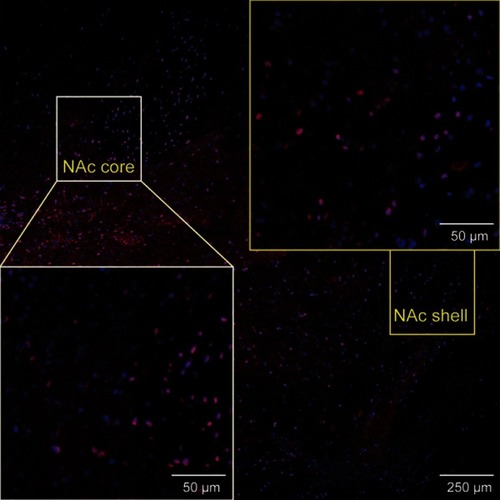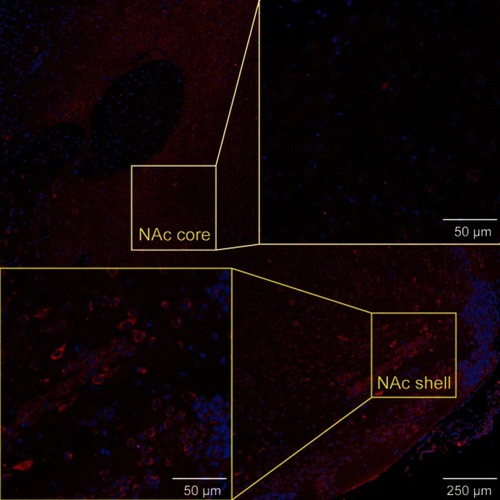Figures & data
Figure 2 Schematic of the brain tissue microdissection for qPCR tests. (A) The frozen and embedded brain was sliced into sections from the rostral to caudal direction using a freezing microtome. When the slice was at the level of the target nucleus, a 0.5*0.5*0.5 mm3 tissue was dissected from the corresponding nucleus. The locations of the nucleus accumbens, LH and VTA are displayed in the right panels of Figure 2A. (B - D) Locations of the nucleus accumbens shell and core (Figure 2B), LH (Figure 2C), and VTA (Figure 2D) in the coronal plane. LH, lateral hypothalamus; LV, lateral ventricle; NAc, nucleus accumbens; Shell, nucleus accumbens shell; Core, nucleus accumbens core; VTA, ventral tegmental area.
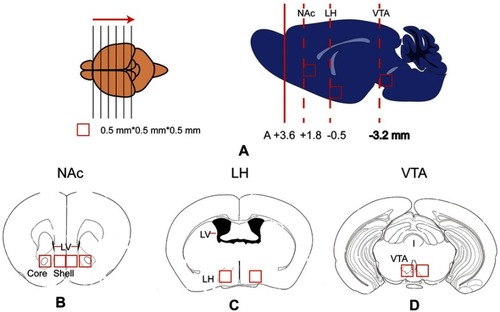
Figure 3 Stress induced by an acute flashing LED light decreased the consumption of both chow and palatable food. (A) Effect of LED (with lihgt intensity of 100 lm/s) stress on chow food intake; (B) Effect of LED (with lihgt intensity of 100 lm/s) stress on palatable food intake; (C) Effect of LED (with lihgt intensity of 300 lm/s) stress on chow food intake; (D) Effect of LED (with lihgt intensity of 300 lm/s) stress on palatable food intake. * denotes significant differences compared with the control group (*P<0.05).
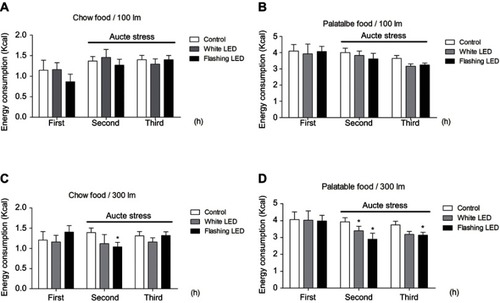
Figure 4 Effect of chronic stress on daily food intake measured from 6:00 pm-8:00 pm in each group. * denotes significant differences in daily food intake between the chronic stress/chow group and chow group, and # denotes significant differences between the fat-bingeing group and chronic stress/fat-bingeing group (*P<0.05, #P<0.05, and ##P<0.01).
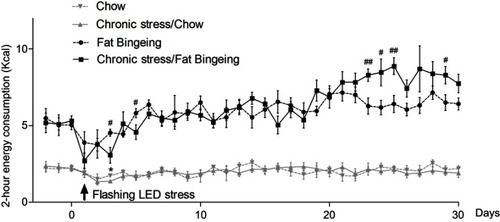
Figure 5 Effect of chronic stress on daily 24 hrs food intake. # denotes significant differences between the fat bingeing and chronic stress/fat bingeing (#P<0.05).
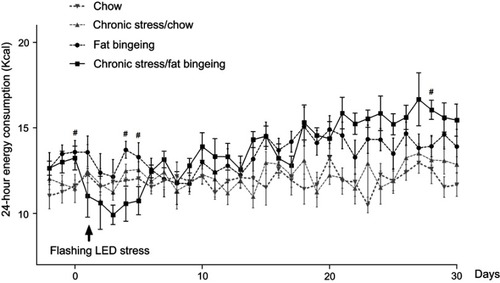
Figure 6 Chronic stress aggravates anxiety-like behaviors. (A) Chronic stress decreased the time in open arm of the mice both in the chow and fat-bingeing feeding mice in the test of EPM test. But chronic stress took no significant effect on the numbers of entries to the open arm (B), time in the light box (C) and shuttle times (D) in the Light/dark conflict test. * denotes significant differences between chow group and chronic stress/chow group (*P<0.05). ## denotes significant differences between fat bingeing and chronic stress/fat bingeing group. (##P<0.001).
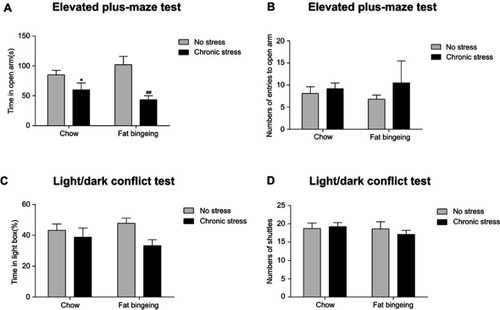
Figure 7 Chronic stress promotes binge eating behaviors in mice fed palatable food. (A) Chronic stress increase daily 2hr energy consumption of palatable food in fat bingeing mice; (B) The ratio of food consumption at 6:00 pm to 8:00 pm of daily food consumption increased in the fat bingeing mice in chronic stress. denotes significant differences between the fat-bingeing group and chronic stress/fat-bingeing group (#P<0.05 and ##P<0.01).

Figure 8 Fat-bingeing increases the motivation for palatable food, but chronic stress enhances the outcomes. In our motivation test, we suspended the food above the floor of the light box. The activity trajectories of the mice were analyzed by reprocessing the video recordings (A). Upon exposure to the chow food signal, there were no significant differences among groups (B). Upon exposure to the chow food signal, mice in fat-bingeing group and chronic stress/fat-bingeing group spent more time in the light box (C). Fat-bingeing increases craving for palatable food after fasting (D). Time in the light box in the presence of the palatable food (E) but not chow food (F) was positively correlated with the craving for palatable food. * denotes significant differences between chow group and due group; # denotes significant differences between chronic stress group and due group (*P<0.05; **P<0.01; ##P<0.01###P<0.001).
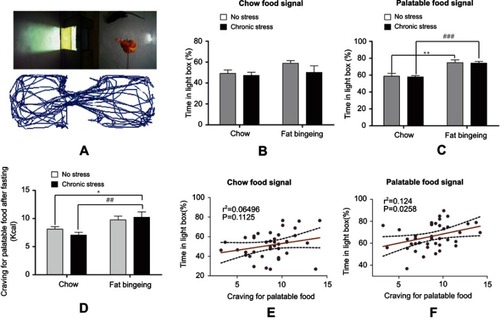
Figure 9 The ultrasonic rat repellent exerts negative effects on both chow food intake (A) and palatable food intake (B).It could increased mices locomotion activities (C) and decreased central area time in the open field test (D). Food intake in the presence of the ultrasonic rat repellent playback was used to measure compulsive eating behavior. Chronic stress aggravated complusive eating in the fat-bingeing mice. (E) Compulsive eating exhibited a strong relationship with the food addiction score (F). * denotes significant differences between control group and due group; # denotes significant differences between chronic stress/fat-bingeing group and fat-bingeing group (*P<0.05; ##P<0.001).
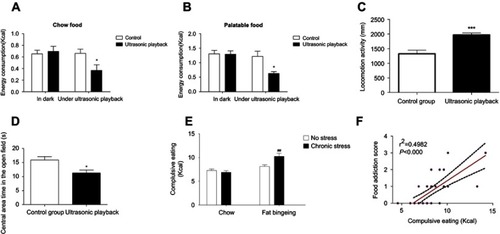
Figure 10 Chronic stress promoted the progress of body weight gain in the fat-bingeing mice (A) and their food addiction score (B). The rate of increase in body weight was positively correlated with the food addiction scale score (C). # denotes significant differences between chronic stress/fat-bingeing group and fat-bingeing group (#P<0.05; ##P<0.001).
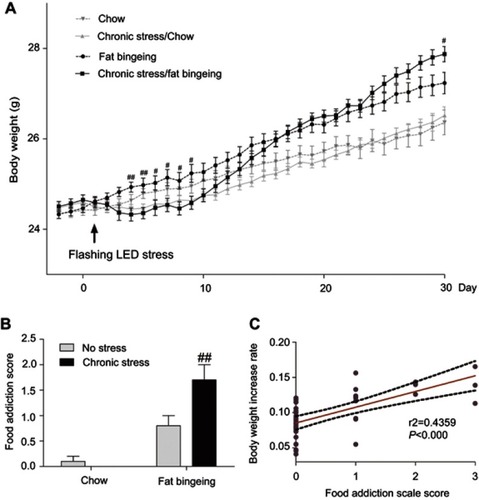
Figure 11 Expression of the CRFR1 mRNA in the nucleus accumbens shell, core, LH and VTA in all groups. (A) Chronic stress increased CRFR1 mRNA expression of nucleus accumbens shell both in the chow food feeding and fat bingeing feeding mice. (B) Chronic stress increased CRFR1 mRNA expression of nucleus accumbens core both in the chow food feeding and fat bingeing feeding mice. (C) Chronic stress increased CRFR1 mRNA expression of LH in the fat bingeing feeding mice. (D) Chronic stress decreased CRFR1 mRNA expression of VTA both in the chow food feeding mice and fat bingeing feeding mice. * denotes significant differences in daily food intake between the chronic stress/chow group and chow group, and # denotes significant differences between the fat-bingeing group and chronic stress/fat-bingeing group (*P<0.05, **P<0.01, ##P<0.01). Abbreviations: NAc-shell, nucleus accumbens shell; NAc-core, nucleus accumbens core; LH, lateral hypothalamus; VTA, ventral tegmental area; CRFR1, corticotropin-releasing factor receptor 1.
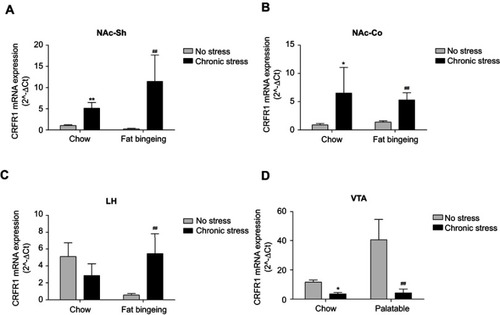
Figure 12 Expression of the DR1, DR2 and MOR mRNAs in the nucleus accumbens shell, nucleus accumbens core and VTA of all groups. (A) Chronic stress takes no significant effect on the DR1 expressions of nucleus accumbens shell. (B) Chronic stress increased DR2 expression of nucleus accumbens shell in fat-bingeing feeding mice. (C) Chronic stress increased MOR expression of nucleus accumbens shell both in chow food feeding mice and fat-bingeing feeding mice. (D) Chronic stress takes no significant effect on the DR1 expressions in nucleus accumbens core. (E) Chronic stress increased DR2 expression of nucleus accumbens core in chow food feeding mice. (F) Chronic stress increased MOR expression of nucleus accumbens core both in fat-bingeing feeding mice. (G) There are no significant differences in MOR expression of LH between no stress and chronic stress group. (H) There are no significant differences in MOR expression of VTA between no stress and chronic stress group. *denotes significant differences in daily food intake between the chronic stress/chow group and chow group, and # denotes significant differences between the fat-bingeing group and chronic stress/fat-bingeing group (*P<0.05, #P<0.05, ##P<0.01).Abbreviations: NAc-shell, nucleus accumbens shell; NAc-core, nucleus accumbens core; LH, lateral hypothalamus; VTA, ventral tegmental area; DR1, dopamine receptor 1; DR2, dopamine receptor 2; MOR, mu-opioid receptor.
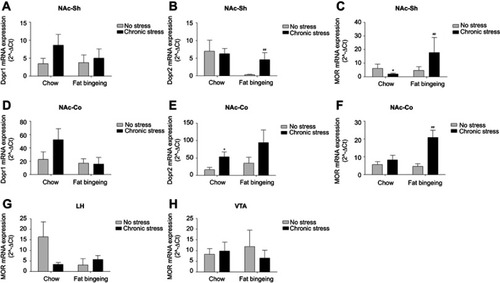
Figure 13 Images of immunofluorescence staining show DR2-positive cells in the slices from each group.

Figure 14 Images of immunofluorescence staining show MOR-positive cells in the slices from each group.
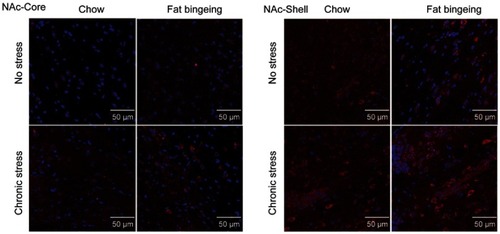
Figure 15 MOR and DR2 expression in the nucleus accumbens (NAcc). (A) Fat bingeing feeding decreased DR2 in NAc-shell but chronic stress increased DR2 of NAc-shell in fat-bingeing feeding mice. (B) Chronic stress increased DR2 of NAc-core in fat-bingeing feeding mice. (C) Chronic stress increased MOR of NAc-shell both in chow food feeding mice and fat-bingeing feeding mice. (D) Chronic stress increased MOR of NAc core in fat-bingeing feeding mice. *denotes significant differences in daily food intake between the fat-bingeing group and chow group, and # denotes significant differences between the fat-bingeing group and chronic stress/fat-bingeing group (*P<0.05, ##P<0.01; ###P<0.001).Abbreviations: NAc-shell, nucleus accumbens shell; NAc-core, nucleus accumbens core; DR2, dopamine receptor 2; MOR, mu-opioid receptor.



